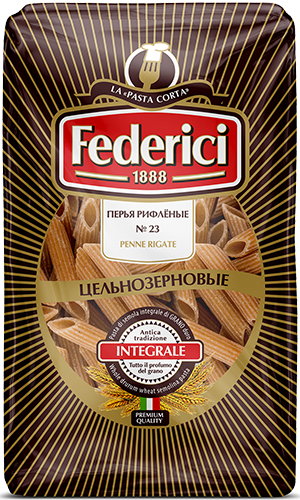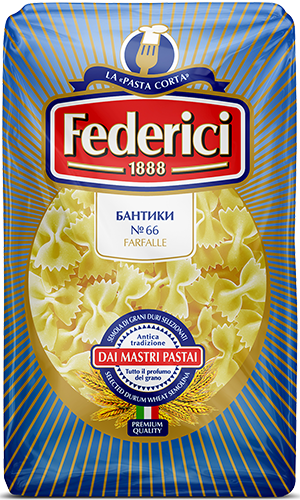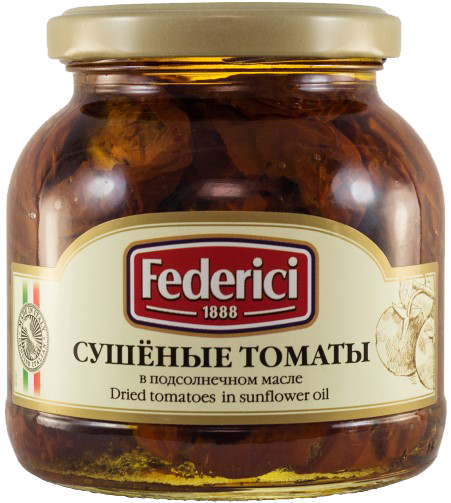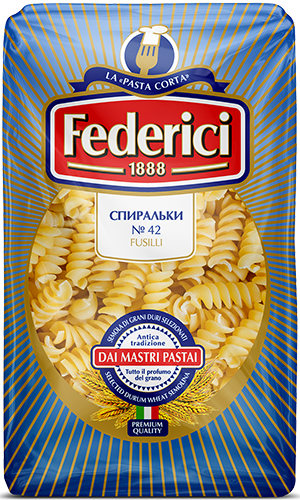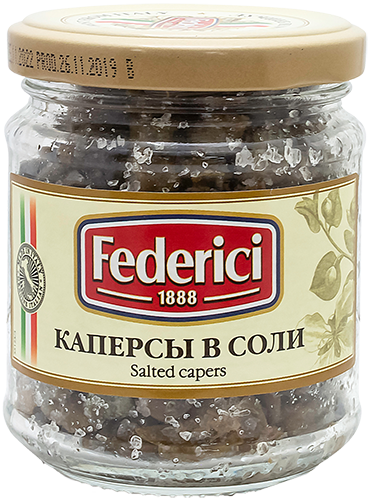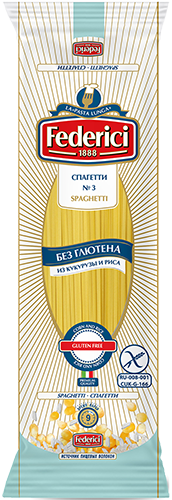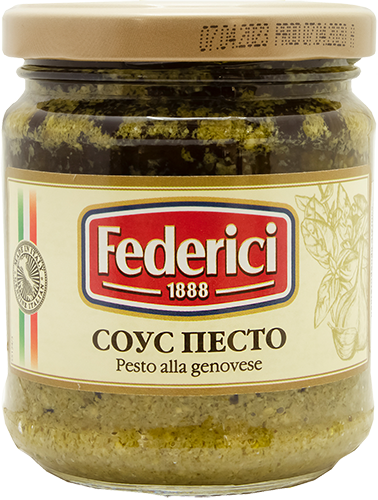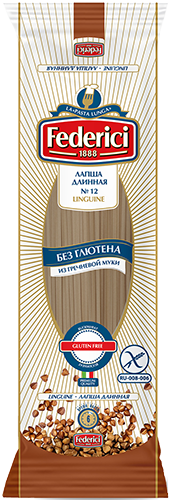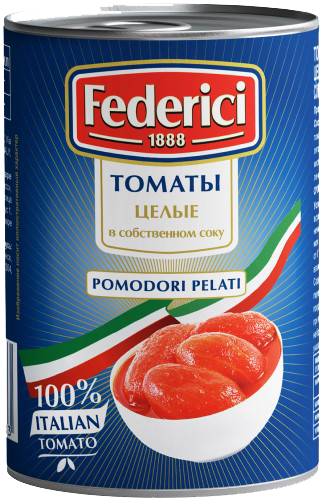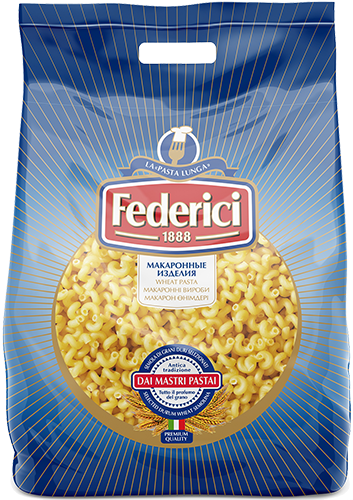


Homemade pasta is a delicious and sophisticated dish that can truly grace any table. If you want to try your hand at cooking and make pasta from scratch, you’ll need not only the ingredients but also the proper cooking technique. In this article, we’ll walk you through the details of this process, sharing the secrets to success and some interesting recipes.
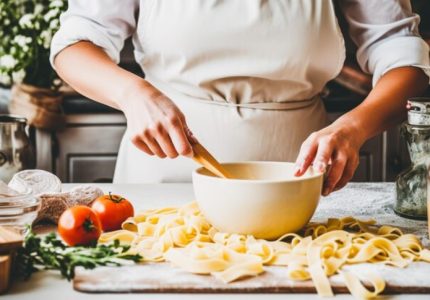 The first step to making homemade pasta is choosing the ingredients. Traditional pasta ingredients are flour and eggs. However, other variations exist, such as using semolina, oat flour, or adding spices to flavor the dough. It’s important to remember that the quality of the ingredients affects the final result, so it’s important to choose fresh, high-quality ingredients.
The first step to making homemade pasta is choosing the ingredients. Traditional pasta ingredients are flour and eggs. However, other variations exist, such as using semolina, oat flour, or adding spices to flavor the dough. It’s important to remember that the quality of the ingredients affects the final result, so it’s important to choose fresh, high-quality ingredients.
To make pasta from scratch, you’ll need simple kitchen tools: a table or work surface to roll out the dough, a fork or bag for mixing the ingredients, a knife for cutting the pasta ribbons, and, of course, boiling water to standardize the finished pasta.
One of the main secrets to successful homemade pasta is properly mixing the ingredients and thoroughly kneading the dough. Form a small well of flour, pour the eggs into it, and begin to slowly mix them with a fork or a pastry bag. Gradually add the remaining flour and continue mixing until the dough is smooth and elastic.
Making Homemade Pasta from Scratch
Ingredients:
- 300 g wheat flour;
- 3 eggs.
Step 1: Prepare the dough.In a large bowl, combine the wheat flour and eggs. Knead the dough thoroughly until smooth and elastic. If the dough is too dry, add a little water. If it is too sticky, sprinkle with a little flour.
Step 2: Rest the dough.Place the dough in a plastic bag or wrap it in plastic wrap and let it rest in the refrigerator for 30 minutes. This will help the dough rest and become more elastic.
Step 3: Rolling and cutting the pasta.Divide the rested dough into several pieces. Roll each piece into a thin sheet, being careful not to let it stick to the counter. Then, make lengthwise cuts to achieve the desired pasta width.
Step 4: Finishing. Let the pasta dry for 15-20 minutes to firm it up. After this, cook it in boiling salted water until tender, which usually takes about 2-3 minutes. Drain the water, and your homemade pasta is ready!
Now you have homemade pasta that can be used in a variety of recipes. Try it with a sauce made with fresh tomatoes, olives, and basil, or with a flavorful mushroom and cream sauce.
Enjoy making homemade pasta from scratch and surprise your loved ones with delicious dishes!
Basic Ingredients for Homemade Pasta
- Wheat Flour: It’s best to use a high-gluten flour, such as type 00 flour. This will help create a springy and elastic pasta texture.
- Eggs: Eggs are a key ingredient needed to bind the flour and give the pasta a richer flavor.
Salt: Adding salt to the dough when making pasta will enhance its flavor and improve its texture. - Salt: Adding salt to the dough when making pasta will enhance its flavor and improve its texture.
- Water: Water is used to combine ingredients and create a smooth, elastic dough.
With these basic ingredients, you can easily make homemade pasta in your own kitchen. Later in the article, we’ll cover the pasta-making process in detail and share many helpful tips and secrets for success.
Making the Dough
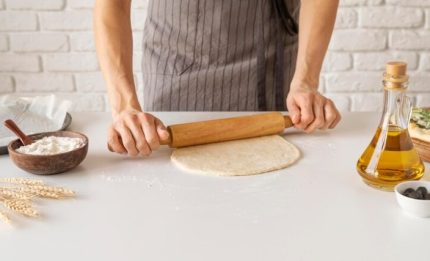 To make homemade pasta, you’ll need pre-made dough. Follow this simple recipe to make your own dough at home:
To make homemade pasta, you’ll need pre-made dough. Follow this simple recipe to make your own dough at home:
Step 1: In a large bowl, combine 2 cups of flour with 1/2 cup of water. You can use wheat flour or a mixture of wheat and yeast flour.
Step 2: Knead the dough until smooth. If the dough is too dry, add a little water. If the dough is too sticky, add a little flour.
Step 3: Transfer the dough to a floured surface and knead for about 5-10 minutes, until soft and elastic.
Step 4: Wrap the dough in plastic wrap and let it rest at room temperature for 30 minutes.
Step 5: After resting, the dough is ready to use! Roll it out thinly and cut into strips to make your homemade pasta.
The secret to success: It’s important to mix and knead the dough correctly to achieve the desired consistency. Resting the dough also helps improve its texture and elasticity.
Mixing the ingredients, kneading the dough, resting the dough
To make homemade pasta from scratch, the first step is mixing the ingredients. In a large bowl, combine the flour and eggs. For the ideal ratio, use one egg for every 100 grams of flour. You can increase or decrease the quantities depending on how much pasta you want to make.
Once the ingredients are combined, begin kneading the dough. Rub the flour into the eggs with your fingers to create a coarse texture. Then, begin vigorously kneading the flour and egg mixture into the dough.
When the dough becomes rough, transfer it to a work surface and continue kneading. Remember to add a little flour to the surface to prevent sticking. Continue kneading until the dough becomes elastic and flexible.
After this, wrap the dough in plastic wrap and let it rest for 30 minutes. This will allow the dough to rest and improve its texture. During this rest, the dough will relax and become more pliable, making it much easier to roll and shape into pasta.
At this point, you can use the time to prepare the sauce or pasta filling. Once the dough has rested, it’s ready to roll and shape into the desired pasta shape.
Preparing and Cutting the Dough
Before you begin making homemade pasta, you’ll need the following ingredients: flour, eggs, salt, and water. You can use regular wheat flour or special pasta flour.
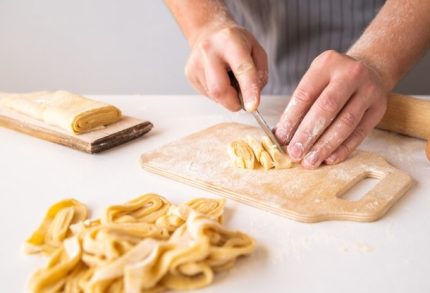 Place flour on a counter or in a large bowl and make a well in the center.
Place flour on a counter or in a large bowl and make a well in the center.- Pour the eggs into the well and season with salt.
- Begin slowly mixing the eggs into the flour, gradually adding flour from the surrounding area.
- Продолжайте смешивать, пока тесто не станет однородным и мягким.
- Transfer the dough to a clean surface and knead it with your hands for about 10 minutes, until it becomes elastic.
- Divide the dough into several equal pieces to make them easier to work with.
- Divide each piece in half and stack them on top of each other to create a more rectangular shape.
- Using a rolling pin or a pastry bag, roll each piece of dough into a thin sheet. If the dough sticks to the counter, dust it with flour.
- Using a knife or a special tool, cut the dough into desired shapes: ribbons, spaghetti, lasagna, etc.
- Unroll the cut pasta and lay it out on a drying rack or clean surface until dry.
Now your homemade pasta is ready to use! You can cook it right away or store it in a dry place until ready to use.
Packaging the dough, rolling it out, and cutting it into shapes
Rolling out the dough is one of the most important steps in making homemade pasta. You need to be very careful and precise to achieve a perfectly smooth and uniform dough. To roll out the dough, you can use a rolling pin—a special tool shaped like a roller—or you can use a regular kitchen glass.
To roll out the dough, you’ll need a small piece of dough. Gradually roll it out, moving the rolling pin or glass away from you. Make sure the dough is rolled out evenly across the entire surface. If the dough is sticking or slipping, dust it with a little flour.
Once the dough has been rolled out to the desired thickness, you can begin cutting the pasta shapes. You can use a pasta press or a simple knife. Choose the shape you prefer based on the type of pasta you want to make. Use a pasta press or a knife to cut the shapes, ensuring they are even and beautiful.
Therefore, correctly rolling the dough, carefully rolling it out, and cutting the shapes beautifully are all important steps in making homemade pasta. Following these guidelines will help you create perfect pasta from scratch.
Making Homemade Pasta
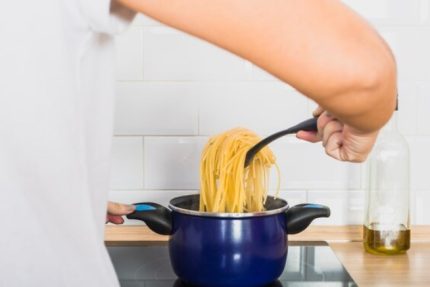
- Choosing Ingredients: Making homemade pasta requires only two basic ingredients: flour and eggs. It’s best to use datura (all-purpose flour, type 00). It has a high elasticity and produces the best results. It’s best to use fresh, organic eggs.
- Preparing the Dough: In a large bowl, combine the flour and eggs. Pour the flour onto the countertop and make a well in the center. Crack the eggs into the well. Using a fork, gradually mix the flour and eggs until they form a smooth paste. Then, continue kneading the dough with your hands until it becomes smooth and elastic.
- Resting the Dough: After kneading, cover the dough with plastic wrap and let it rest for 30 minutes. This will help soften the dough and give it time to “relax.”
- Shaping the Pasta: After resting, divide the dough into several pieces and lightly dust them with flour. Carefully divide each portion into small portions and, using a pasta machine or hand rolling machine, roll each portion of dough into a thin sheet. You can then cut the dough into the desired shape or leave it as sheets.
- Cooking the Pasta: To cook the pasta, bring a large pot of boiling salted water to a boil. Carefully lower the cooked pasta into the boiling water and cook for 2-4 minutes. They are ready when al dente—soft but with a slight resistance to chewing.
- Serving the Pasta: Drain the pasta in a colander to remove excess moisture and serve immediately with your favorite sauce or toppings. Enjoy fresh and flavorful homemade pasta that you made yourself!
Enjoy the process of making homemade pasta and don’t be afraid to experiment with different flours and toppings. It’s time to start making your own homemade pasta!
Preparing Boiling Water, Adding Pasta, Cooking, and Separating
First, to make homemade pasta, you need a large pot of boiling water. To do this, fill a large pot with water and bring to a boil.
When the water boils, add a pinch of salt—this will give the pasta a pleasant flavor. Now you can add the cooked pasta to the boiling water. You can use fresh homemade pasta or store-bought pasta.
Stir the pasta occasionally to prevent it from sticking to the sides of the pot or clumping together. Follow the cooking time recommendations on the pasta package, which usually takes about 8-10 minutes.
When the pasta is done, drain it using a colander or sieve. Be sure to shake the sieve gently to remove all the water, as excess moisture can ruin your dish. If necessary, rinse the pasta under cold water to stop the cooking process. Now you’re ready to use your fresh homemade pasta or add it to your favorite dish.
Serving
Homemade pasta, prepared with love, deserves a special presentation. Here are some tips for garnishing and seasoning your pasta.
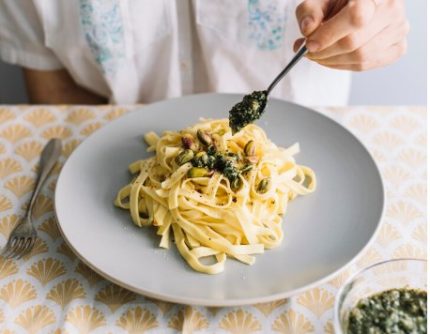 Sauces – Choose a sauce that complements the main ingredients of your pasta. For example, a lemon sauce or a garlicky olive oil sauce works well with seafood pasta. A creamy cheese sauce is ideal for creamy pasta.
Sauces – Choose a sauce that complements the main ingredients of your pasta. For example, a lemon sauce or a garlicky olive oil sauce works well with seafood pasta. A creamy cheese sauce is ideal for creamy pasta.- Seasonings – Add fresh herbs and spices to give your pasta extra flavor. You can sprinkle fresh basil, parsley, or oregano over the pasta before serving. Don’t forget to season your pasta with salt and pepper to taste.
- Cheese – Using Parmesan or another hard cheese to season your pasta will add flavor and tenderness to the dish. Sprinkle the finished pasta with grated cheese before serving.
- Garnish – You can garnish your pasta with fresh herbs or a thin strip of citrus zest. This will add elegance and a delicious appearance to the dish.
- Serving – Keep in mind that the right serving utensils for pasta add a special charm. You can use tall plates, special pasta bowls, or beautiful deep bowls. Before serving, carefully arrange the pasta on a plate and garnish with fresh herbs.
Follow these tips and you’ll impress your guests and enjoy the unparalleled flavor of homemade pasta.
Preparing Sauces, Seasonings, and Garnishes
Homemade pasta can be quite delicious on its own, but to add a variety of flavors and aromas, you can add sauces, seasonings, and garnishes. In this section, we’ll look at several popular options.
- Tomato Sauce: To make tomato sauce, you’ll need ripe tomatoes, garlic, olive oil, salt, pepper, and fresh herbs such as basil and parsley. Chop the tomatoes, removing the seeds. Then sauté the tomatoes in olive oil with the garlic. Add salt, pepper, and herbs, and simmer for a few minutes until the sauce thickens.
- Creamy Sauce: To make a creamy sauce, you’ll need heavy cream, butter, garlic, thyme, and salt. Heat the heavy cream in a frying pan, then add the butter and finely chopped garlic. Add thyme and salt to taste. The sauce is ready when the butter has completely melted and the sauce is smooth and fragrant.
- Pesto: Pesto is an Italian sauce made with basil, olive oil, Parmesan cheese, and garlic. Place all ingredients in a blender and blend until smooth. Pesto pairs perfectly with homemade pasta and adds a unique flavor.
Once your pasta is cooked and the sauces are prepared, you can add various seasonings and garnishes to give the dish the finishing touch.
- Cheese: You can sprinkle the pasta with grated Parmesan cheese or any other cheese of your choice. The cheese adds a piquant and rich flavor to the dish.
- Fresh Herbs: Grated fresh herbs like basil, parsley, arugula, or cilantro will add a fresh flavor to your pasta and brighten the dish.
- Nuts: Adding various nuts, such as walnuts or pine nuts, will give your pasta a delicate and aromatic finish.
Don’t be afraid to experiment with different sauces, seasonings, and garnishes to create a homemade pasta that reflects your personality and satisfies even the most discerning palates!
Our products
Мы стремимся предложить Вам наилучший сервис при работе с нашим сайтом. Для этого мы собираем и храним информацию о Вашем посещении сайта. Так называемые cookies. Файлы cookies не собирают и не хранят никакую личную информацию о Вас. Используя этот сайт, Вы даете согласие на использование cookies. На данном этапе Вы можете отказаться от использования cookies, настроив необходимые параметры в своем браузере.
